Second Language Proficiency Test

Welcome to the Second Language
Proficiency Test (TPLS)!
Before starting, follow the instructions on the home page. Once you start the test, answer all the questions without any help, even if you are not sure of the answers.
The test is divided into two main sections and takes about 90 minutes to complete. You may take a break after the first section of the test if you wish. Your results will be automatically saved. To return to the test, go back to tpls.ca/SLPT/passation, enter your username and password, and click Continue Test. The test will resume where you left off.
For further information, see the help menu on the left.
Logging In
Here are the steps to log in to the Second Language Proficiency Test (TPLS):
- Listen to the instructions on the home page and adjust the volume for the test audio files.
- Complete the identification form.
- Enter your username and password.
- Click the Continue button.
Form
Only the username and password sent to you are required to take the test. However, the manager who registered you for the TPLS may ask you to provide additional information. You can enter:
- your last name,
- your first name,
- your gender,
- the language most often used to communicate with your loved ones (language spoken at home),
- the option that you feel best matches your French proficiency level (Self-assessment of French level). Note that the level you select does not affect the testing method or your results.
Note: The institution or organization that registered you for the test may keep your personal data and results for administrative purposes. As for the organization that designed the test (the Collegial Center for Educational Materials Development or CCDMD), it only keeps anonymized results for statistical analysis.
Username and Password
Enter the username and password you were provided for the TPLS in the corresponding fields.
Note: If you do not have your username or password, contact the test manager at the institution or organization that registered you for the TPLS.
Continue Button
Once you have entered your personal information along with your username and password, click the Continue button. You will be redirected to the test presentation page.
![]()
Technical Support
If you are taking the TPLS in a classroom or lab
In the event of a problem with your username or password, contact the manager who registered you for the test. If you cannot reach the manager, contact a staff member at the institution where you are taking the test.
If you are taking the TPLS at home
In the event of a problem with your username or password, contact the manager who registered you for the test. If you cannot reach the manager, contact the CCDMD technical support team at 514 873-7823 or soutien@ccdmd.qc.ca.
Take the Test
The main objective of the Second Language Proficiency Test (TPLS) is to determine your level of proficiency in French. You will obtain a result from 1 to 10 corresponding to the levels of the Scale of Second Language Proficiency Levels. For more details, see the proficiency levels descriptions.
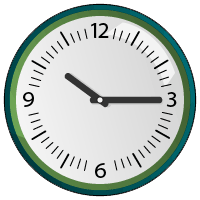
The test takes 60 to 90 minutes to complete. It is divided into two main sections: oral comprehension and written comprehension. The test cannot be stopped in the middle of a section. You may take a break after completing the questions on oral comprehension. Your answers will be automatically saved. To return to the questionnaire, go back to tpls.ca, click Continue Test, and enter your username and password. The test will resume at the beginning of the section on written comprehension.
You can access the questionnaire from any computer connected to the Internet. The test is optimized for Internet Explorer (version 9.0 or later) and Firefox (version 8.0 or later). Make sure your browser version is adequate.
Read the Test Introduction Page
Read the first page of the test carefully. Also refer to other TPLS help topics as needed. You will not have access to them while you answer questions.
When you are ready, click the Continue button.
Answer the Questions
The test items are very varied; familiarize yourself in advance with the types of questions you will be asked. Before answering a question, always read the instructions at the top of the page and the answer choices provided. Some questions may seem more difficult than others; answer them as best you can, even if you are not quite sure of your choice.
Test questions are grouped into two categories: oral comprehension and written comprehension.
ORAL COMPREHENSION (Listening)
For each oral comprehension question, you will need to listen to a conversation, a news report or some other type of spoken message.
- First read the question and answer choices.
- Then click the Play button to listen to the audio file. Pay attention: you may only listen to it once.
WRITTEN COMPREHENSION (Reading)
Written comprehension questions all relate to a short text (a recipe, an invoice, a blog article, etc.).
Read this text and look at the images before answering the question.
TIMER
All questions are timed. You can see the timer near the question.
- If you answer a question before the end of the allotted time, click the Continue button to go to the next question.
- If you do not respond in time, a new question will be automatically presented.
Answer all the questions, even if you are unsure of some of your answers.
Note: In the oral comprehension section, the timer only starts when the audio file has finished playing. In the written comprehension section, the timer starts as soon as the question is displayed.
Finish the Test
Your answers are analyzed as you progress through the test. A message will appear once you proficiency level has been determined; the test is then complete.
Sample Questions
The TPLS includes five types of questions:
- Associations
Drag and drop the answer choices to form pairs. - Multiple choice
Select the correct answer from a list of possible answers. - Sequencing
Drag and drop the answer choices in the correct order to form a logical text. - Cloze text with drag-and-drop
Drag and drop the correct answers into the blank spaces. - Cloze text with menus
Select the correct answer from a list of possible answers.
Associations
The answers to the following question can be found in this text:

Drag and drop the answer choices to form pairs.
Respond to an association question by pairing each of a set of elements in the 2nd column with one of the choices provided in the 1st column. Association questions are used to assess your recognition and recall of related information. Your response is deemed correct when you have successfully matched all of the elements.
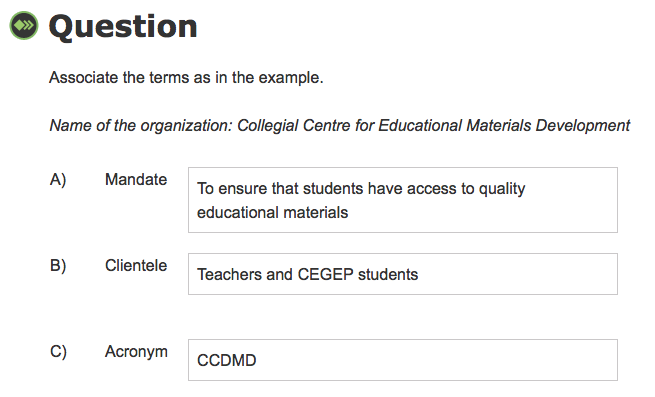
Multiple choice
The answer to the following question can be found in this text:

Select the correct answer from a list of possible answers.
Respond to a multiple choice question by selecting the correct answer from a list that includes the correct answer and several incorrect answers. Multiple choice questions are used to test your comprehension of a broad range of content. The context of the item and the type of response required determines whether the item is recall or interpretation. Your response is deemed correct when you have selected the single correct answer.

Sequencing
The answers to the following question can be derived from this text:

Drag and drop the answer choices in the correct order to form a logical text.
Respond to a sequencing question by dragging the elements into the correct order. Sequencing questions are used to test your ability to recall a series of events or a process in the order in which it was presented. They measure your ability to construct meaning and comprehend logical consequences expressed in verbal or written form. Your response is deemed correct when you have arranged all of the elements in the correct order.
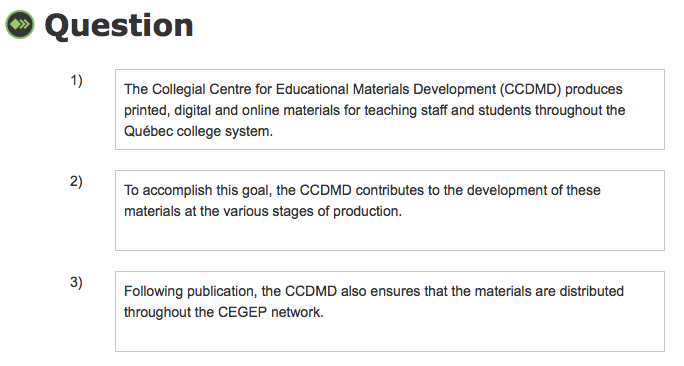
Cloze text with drag-and-drop
The answers to the following question can be found in this text:

Drag and drop the correct answers into the blank spaces.
Respond to a cloze text with drag-and-drop question by filling in the blanks in a text. Drag the correct answer from a predefined set of possible answers above the text to the appropriate blank in the text. Cloze text with drag-and-drop questions are used to assess your language skills by imitating the editing process. They measure your ability to infer the most appropriate conclusion to an incomplete statement. Your response is deemed correct when you have filled in all of the blanks correctly.
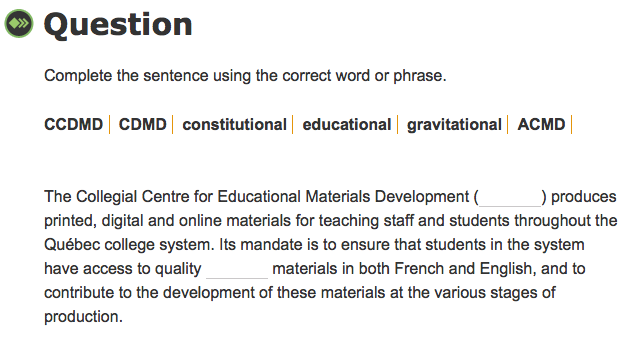
Cloze text with menus
The answers to the following question can be found in this text:

Select the correct answer from a list of possible answers.
Respond to a cloze text with menus question by filling in the blanks in a text. Select the correct answer from a predefined list of possible answers. Cloze text with menus questions are used to assess your ability to compare options and make accurate choices. Cloze text with menus questions are simpler to decode than cloze text with drag-and-drop, as they narrow the range of correct answers. Your response is deemed correct when you have selected the single correct answer.
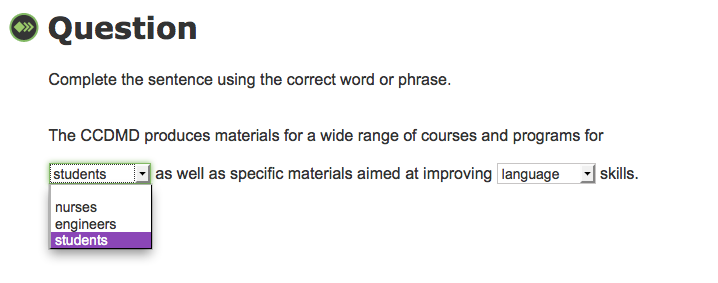
Scale of Proficiency Levels
The Scale of Second Language Proficiency Levels for the College Student describes the development of second language proficiency in 10 levels. For each level, it defines what the learner is able to understand orally and in writing.
To get more information about each level, you can consult the proficiency level descriptions. In addition, your instructor can use this information to plan activities that will help you progress to a higher level.
Proficiency level descriptions
The proficiency test is made up of a number of items divided into two categories:
- Items that focus on audio recordings and measure the respondent’s degree of proficiency in oral comprehension.
- Items that focus on texts and measure the respondent’s degree of proficiency in written comprehension.
Oral Comprehension
The items measuring oral comprehension are based on audio recordings, which vary in length and complexity depending on the target proficiency level. The audio recordings serve as the foundation for the questions appearing in one or more items.
Each item in oral comprehension includes:
- General instructions, given in words and images, which specify what you must do, i.e., read the question and the choice of answers BEFORE listening to the recording;
- The audio recording, which starts automatically after a 15-second pause and plays only once. The volume can be adjusted with the slider bar on the screen. The recording can vary in form (audio message, dialogue, discussion, etc.) and provides the basis for the item question; some recordings are accompanied by an image illustrating the context. You cannot answer the question until the recording has ended.
- The question;
- The choice of answers;
- The Continue button to go to the next item.
LEVELS 1-2 OC
Level 1
| In predictable situations, with the support of the speaker, I understand a few isolated words and expressions. I can: |
- understand information related to times, dates, telephone numbers, addresses;
- understand information related to the days of the week and months of the year;
- identify the parts of the body.
Level 2
| In predictable situations, with the support of the speaker, I understand simple sentences and short conversations. I can: |
- understand information related to colours;
- understand information and requests;
- understand information related to an institution;
- follow directions to find my way around an institution;
- understand information related to height, weight and age.
LEVELS 3-4 OC
Level 3
| In predictable situations, I understand the gist of a simple conversation or message. I can: |
- understand information related to measurements;
- understand information related to a housing or domestic problem;
- understand information related to leisure or recreation;
- understand the main idea in an advertisement.
Level 4
| In predictable situations, I understand the meaning of a simple conversation or message. The topic is familiar, the speech is clear, and the ideas are presented in a direct manner in everyday language. I can: |
- understand the main ideas in a presentation;
- understand information related to who?, what?, when?, where? questions;
- understand a telephone message;
- understand a sequence of events based on time markers;
- grasp the intention of a message;
- situate events by identifying time and frequency indicators.
LEVELS 5-6 OC
Level 5
| In predictable situations, I understand the progression of ideas. The topic is concrete and familiar, the speech is clear, and the ideas are expressed succinctly in everyday language. I can: |
- follow a conversation;
- understand key points in a presentation;
- grasp the main ideas in a television or radio show;
- understand the relationship between speakers;
- understand the main ideas in a conversation;
- understand the intention of communication.
Level 6
| In predictable situations, or partially predictable situations, I understand conversations and discourse on concrete topics. I can: |
- understand primary and secondary ideas;
- distinguish fact from opinion;
- anticipate a conclusion or recommendation;
- grasp the relationship between speakers.
LEVELS 7-8 OC
Level 7
| In predictable situations or partially predictable situations, I understand conversations or discourse on various concrete topics. The language is standard and speech is at a normal rate. I can: |
- follow most conversations with ease;
- follow a conversation on work or recreational activities;
- make inferences about the attitudes and emotions of speakers or about the mood of a conversation;
- understand a variety of common words and popular idiomatic expressions.
Level 8
| In predictable situations or partially predictable situations, I understand conversations and opinion discourse on various concrete topics. I can: |
- follow most conversations in formal and informal contexts;
- understand a structured presentation given the presence of questions and answers; markers (first, etc.); and words related to a presentation or opinion (present, think, believe, etc.);
- distinguish fact from opinion;
- grasp, comparisons, contrasts, and cause and effect relationships.
LEVELS 9-10 OC
Level 9
| In sometimes unpredictable situations, I understand conversations and discourse on various, sometimes abstract topics. I can: |
- understand points (for and against) that will facilitate decision-making;
- distinguish fact from opinion in a discussion or presentation, even when implicit;
- recognize the tone of a conversation or a presentation;
- understand abstract remarks.
Level 10
| In sometimes unpredictable situations, I easily understand conversations and discourse on various sometimes abstract topics. I can: |
- understand criticism or reservations expressed during formal exchanges;
- follow discourse even when speech is at a fast rate;
- infer contradictions;
- deduce the values conveyed by discourse.
Written Comprehension
The items measuring written comprehension are based on written texts, which vary in length and complexity depending on the target proficiency level. The texts serve as the foundation for the questions appearing in one or more items.
Each item in written comprehension includes:
- General instructions, given in words and images, which specify what you must do, i.e., read the question and choice of answers BEFORE reading the text;
- The text, varying in type (invoice, birthday card, film poster, etc.), which provides the basis for the item question;
- The question;
- The choice of answers;
- The Continue button to go to the next item.
LEVELS 1-2 WC
Level 1
| Documents are very simple, relate to personal identity and refer to immediate needs. I understand words, expressions or sentences. I can: |
- recognize everyday words and known names of people and places;
- recognize common abbreviations;
- identify the months of the year;
- find elements related to personal identification to enter in a form.
Level 2
| Documents are very simple, relate to personal identity and refer to immediate needs. I partially understand brief, simple texts. I can: |
- find information in various documents;
- recognize numbers written out in full;
- recognize information used in weather forecasts.
LEVELS 3-4 WC
Level 3
| Documents are very simple or related to advertising and refer to daily life. I understand the gist of brief, simple texts. I can: |
- understand informative documents;
- understand brief descriptions;
- understand information with the help of key words or visual cues;
- identify basic grammar forms.
Level 4
| Documents relate to concrete topics and refer to daily life. The language is simple and common. I understand a few paragraphs. I can: |
- situate facts, academic events, classroom activities and instructions in time;
- grasp the sequence of steps in directions;
- answer general comprehension questions (who?, what?, when?, where?);
- compare facts in order to make a choice.
LEVELS 5-6 WC
Level 5
| Documents relate to concrete topics and may include some complex elements, such as certain uncommon words. I partially understand a few paragraphs. I can: |
- identify information in a news article;
- identify information in an informative text;
- demonstrate my understanding by associating information in a text;
- find relevant information in a notice.
Level 6
| Documents relate to familiar topics and may include some complex elements, such as uncommon words. I understand the main information in a one-page text. I can: |
- identify all the pertinent information in a news article;
- infer the link between paragraphs;
- identify certain cohesion markers in a text;
- demonstrate my comprehension of a text made up of complex sentences that contain common relationship markers.
LEVELS 7-8 WC
Level 7
| Documents relate to subjects of general interest and may include complex elements, such as uncommon words or certain implicit concepts. I understand the main idea in a text. I can: |
- identify the main idea and secondary ideas;
- differentiate fact from opinion.
Level 8
| Documents relate to subjects of general interest and include arguments. Texts may relate to a specific field of study. They include complex elements, such as uncommon words, implicit concepts and abstract ideas. I understand the main idea in documents of several pages. I can: |
- identify the main idea;
- recognize different points of view;
- understand an article related to my field of study;
- understand a literary text.
LEVELS 9-10 WC
Level 9
| Documents include various complex elements, and may address unfamiliar or abstract topics. I understand the main idea in complex documents. I can: |
- recount the author’s arguments;
- recognize the function of linking words in a text;
- identify the main idea and pinpoint some details.
Level 10
| Documents include various complex elements, and address abstract topics. I understand the main idea, the tone and explanations in complex documents. I can: |
- recognize adjectives, adverbs and other words that convey tone;
- recognize subtext;
- recognize the links of cause, intention, time and consequence, expressed by the most common subordinating words.
About
The Second Language Proficiency Test (TPLS) is a tool designed by the Collegial Centre for Educational Materials Development (CCDMD).
The test is used by subscription only, and anyone wishing to use it for commercial purposes must enter into a specific agreement with the CCDMD. If you have any questions about the subscription or the TPLS, please contact the CCDMD by email at tpls@ccdmd.qc.ca or by telephone at 514 873-2200.
Design and Production Team
Application Design
Research, Educational Design and Drafting
Project Management
Test Evaluation
Translation
Drafting of Implementation Guide
Language Editing
|
System Design and Programming
Web Integration
Graphic Design
Audio Production
Voice
|
AcknowledgmentsDeborah Armstrong, Rebecca Baker, Chantal Bélanger, Kathye Bélanger, Philippe Bonneau, Marie-Pierre Bouchard, Yvonne Christiansen, Marie-Claude Doucet, Cathie Dugas, Paul Fournier, Philippe Gagné, Sylvain Gagnon, Francine Gervais, Sue Harrison, Réjean Jobin, André Laferrière, Charles Lapointe, James Laviolette, Julia Lovatt, Michel D. Laurier, Susan MacNeil, Anne McMullon, Jean-Denis Moffet, Andrew Moore, Joanne Munn, Ian Murchison, Colette Noël, Patrick Peachey, Christian Ragusich, Michael Randall, Pierre Richard, Joan Thompson, Rachel Tunnicliffe, Inèse Wilde
The TPLS was designed for the college network in response to current needs, with the objective of promoting academic success for young students in Québec. Many teachers, professionals and students collaborated in the development of the test and its validation. We would like to thank them all for their valued contributions. This project is funded by the Québec Ministère de l'Éducation et de l'Enseignement supérieur (MEES) and the Canada-Québec Agreement on Minority-language Education and Second-Language Instruction. |